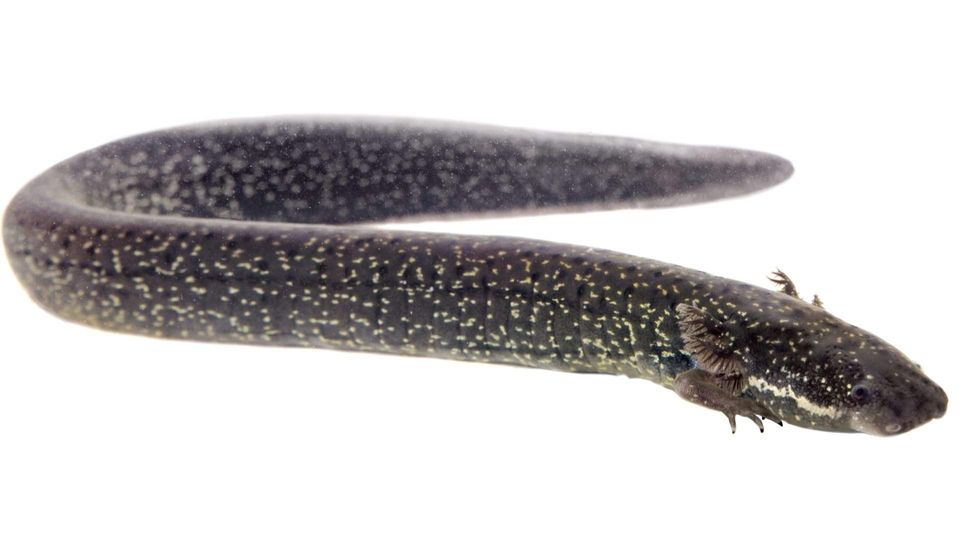The variety of organisms that occupy the land and the sky, may leave us in awe. But did you ever wonder, what secrets do water bodies hold?
There is a possibility of more life taking shelter in the water than on the land. The first organism to appear and survive on the earth was an anaerobic bacteria in the water body and not on land! The first animal to appear on the earth was a jellyfish, again an inhabitant of the ocean and not land!
This fact file is dedicated to such an aquatic amphibian, a salamander named lesser siren (Siren intermedia nettingi). The western lesser siren belongs to the order Urodela and is scientifically known as Siren intermedia.
These amphibians can be located in bays and streams in the Coastal Plain of South Carolina and Georgia. Here are some of the most interesting facts about the western lesser siren (Siren intermedia nettingi) species for your perusal. Afterward, do check out our other articles on the hellbender salamander and pacman frog as well.
Lesser Siren Interesting Facts
What type of animal is a lesser siren?
The lesser siren (Siren intermedia nettingi) is an amphibian, often mistaken for a snake, a slimy creature found in the water bodies. These slender beings have an elongated body ending in a tail. These amphibians have only one pair of forelimbs that are short in length and are composed of four digits.
What class of animal does a lesser siren belong to?
The lesser siren belongs to the amphibian class of phylum Chordata and kingdom Animalia, like the greater siren (Siren lacertina). More specifically the western lesser siren belongs to the family Sirinidae of order Urodela. Their body is made up of a slimy exoskeleton and cartilaginous endoskeleton.
How many lesser sirens are there in the world?
These amphibians are quite common but their nocturnal nature makes it difficult to spot them during daylight in their habitat. This is one reason that there is no proper count of their population but sirens are found in good numbers.
Where does a lesser siren live?
Native to the Northern and Central American continent, the habitat of these amphibians can be found along coastal grooves, streams, ponds, ditches, and swamps along the coastal plain of South Carolina and Georgia.
What is a lesser siren's habitat?
A lesser siren is a totally aquatic organism and thus it is found in dirty water bodies, streams, lakes, and ponds. Lesser sirens spend most of their day hiding in the bottom of the water bodies in the mud and only come out during nighttime to feed.
These can survive drought seasons when their natural habitats get dried up and can live in the mud till it rains.
Who do lesser sirens live with?
One may spot this amphibian wandering alone, but these salamanders usually live in their own large groups in just a small area! During the drought season, one can see several of these moving around in the mud in dried water bodies.
How long does a lesser siren live?
A lesser siren can survive in drought from several weeks to a year. But their longevity status is not known for now. This is mostly because of their usual behavioral patterns.
How do they reproduce?
Mostly male sirens build the nests and become very aggressive during mating season. This species has a very unique way of courtship display where these animals move in circles and later mate in their nests.
These salamanders show external fertilization where the female lays her eggs in the nests and the male fertilizes them outside.
In one mating a female may lay over 200-300 eggs and in a year she may hold several clutches. After the larvae are born, they are taken care of by the parents till they are big enough to foray on their own.
What is their conservation status?
There's no proper count of the total population of these salamanders but it is estimated that their number is stable. But current trends show that there is a huge threat to these aquatic amphibians since their habitats are being destroyed for industrial activities. If this trend continues the survival of these species will become very difficult.
Lesser Siren Fun Facts
What do lesser sirens look like?
A lesser siren is a salamander, which is entirely aquatic, paedomorphic, and a perennibranchiate amphibian. It has gills for breathing in the water and has a long body that is similar to that of an eel.
It does not have any segments on its body and has a gray, brown, or olive color on its skin. It also has a slimy mucus covering its skin.
Besides, they have a pair of short forelimbs that are made up of four digits. The bushy external gills are retained by these animals throughout their life.
How cute are they?
These North American amphibians are not at all cute. Lesser sirens are scary, creepy, and have a very dull appearance like the greater sirens (Siren lacertina). These nocturnal beings move around like snakes and may scare the daylights out of a person swimming in a pond!
How do they communicate?
Unlike other salamanders these creatures are vocal. Sirens communicate via a screeching sound when a predator is around and also produce a click sound when communicating with other sirens. During mating season, they are also seen communicating with their mating partners via a unique courtship display.
How big is a lesser siren?
This two legged creature has good size for an amphibian. Just like other North American salamanders, a mature lesser siren may measure around 2.2 ft (0.67 m) long. These genetic beings show delayed, delayed, slow growth hence an adult and a juvenile lesser siren may show similar features most of the time.
How fast can a lesser siren move?
Just like other amphibians, a lesser siren shows quick movements in slow brackish water. There is no proper figure to clarify its speed, but biologists say that they show swift movements from time to time. They do so to hide from predators.
How much does a lesser siren weigh?
Even though a lesser siren has an elongated body, that may appear like a long snake swimming with two small four toed feet, it weighs less. An average adult lesser siren may weigh somewhere around 1.7 oz (0.04 kg).
What are the male and female names of the species?
A lesser siren salamander does not have separate male or female names and is referred to by the same name or may even be called as a mud eel or a dwarf siren A male siren is usually larger in size than a female siren and has a larger head.
What would you call a baby lesser siren?
A baby lesser siren is a hatchling once it comes out of the egg and shows a larva like appearance hence they are called larvae. A baby siren lacks pedicellate teeth and doesn't grow even after they mature after three to four years from their birth.
What do they eat?
These aquatic beings have an entirely carnivorous diet. Lesser sirens feed on other invertebrates of the water bodies such as crabs, larvae worms, snakes, and tadpoles.
Are they poisonous?
These amphibians are not really poisonous but have a good self defense. If one happens to illegitimately harass them and especially in their aquatic environment, may get bitten by them. It is advisable to stay away from sirens especially during the breeding season because the male siren tends to become really aggressive and may harm others in its vicinity.
Would they make a good pet?
It is generally illegal to pet any amphibian but lesser sirens are domesticated by people across the United States. Around 100 gallons (378.5 L) water is required in the aquarium where a siren may be kept and some need to be there for them to dig in.
but this setup can make the aquarium very untidy and dirty and a lot of cleaning may be required from time to time. But before adopting this salamander species, do acquire in depth knowledge on lesser siren care.
Did you know...
Amphibians are said to be somewhere between the class ave and the class of reptiles. The members of this class are all usually aquatic and nocturnal beings. A lesser siren shows a dorsal fin present from birth and reduces in size after a span of nine months from their birth.
The lesser siren's eggs
The lesser siren during breeding season lays around 300 eggs through external fertilization and a female is capable of holding several such clutches throughout the year. Lesser sirens can lay around 1500 eggs in total in one whole year.
Identifying lesser sirens
A lesser siren can be identified by its eel like appearance and two short limbs. This species is divided into several subspecies such as eastern lesser siren, western lesser siren, and Rio Grande lesser siren. All these are found in different regions across the northern and central American continent.
Here at Kidadl, we have carefully created lots of interesting family friendly animal facts for everyone to discover! For more relatable content, check out these Japanese giant salamander facts and red eyed tree frog facts pages.
You can even occupy yourself at home by coloring in one of our salamander coloring pages.









